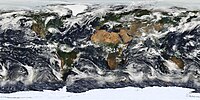
Photo from wikipedia
Abstract Continuous monitoring of cloud fraction (CF) using a Whole Sky Imager (WSI) equipped with an infrared (IR) camera, play a crucial role in validating satellite data and numerical models.… Click to show full abstract
Abstract Continuous monitoring of cloud fraction (CF) using a Whole Sky Imager (WSI) equipped with an infrared (IR) camera, play a crucial role in validating satellite data and numerical models. WSI is operated at a high altitude station located in the complex terrain of Western Ghats (WG) of peninsular India from December 2016 to May 2019. CF is retrieved continuously for 24 h at a high temporal resolution (5 min) and a unique time series is constructed for thick, thin, and total cloud cover. The retrieved CF is compared with MODIS (Aqua and Terra satellites) CF during the overpass times over the study area. Good correlation is observed, however, more bias is observed during broken/partial clouds. The biases also arise due to the viewing angles, sensor field of view, and sensitivity of the measurement techniques. The diurnal (24 h) cycle of total CF showed high variability in all the seasons except in monsoon where 90–100% CF is observed throughout the season. The post-monsoon and winter showed high variability due to the occurrence of unusual cyclonic systems in the Arabian Sea as well as in the Bay of Bengal. The temporal monthly mean CF showed significant variability in day and night, with bi-modal and mono-modal distributions in winter and pre-monsoon, respectively during day time, while nights showed mostly flat distribution. Thin CF is also observed in all the months and showed high irregular variability in the range of 2–6%. On a seasonal scale, the observed CF is 50%, 45%, 100%, 60% for winter, pre-monsoon, monsoon and post-monsoon, respectively. The difference in day and night CF is observed only during winter with day CF more than night CF. The study infers that cloud events/characteristics observed on a temporal scale get averaged out on diurnal, monthly, and seasonal scales. When compared with MODIS diurnal and seasonal variability, large biases are observed on a regional scale due to high CF variability, and more importantly, fewer satellite observations representing the day average.
Journal Title: Atmospheric Research
Year Published: 2021
Link to full text (if available)
Share on Social Media: Sign Up to like & get
recommendations!